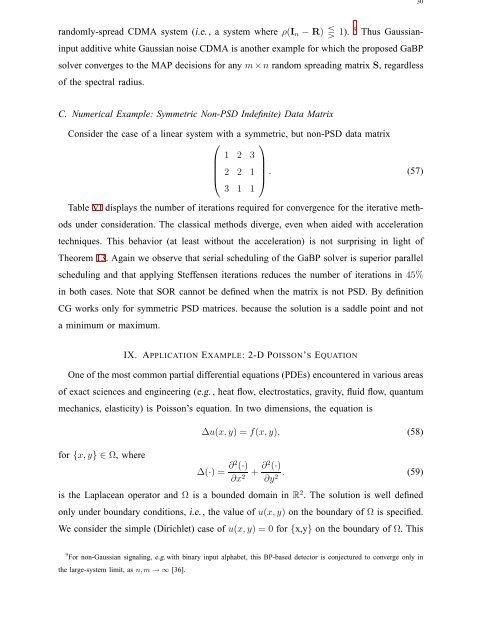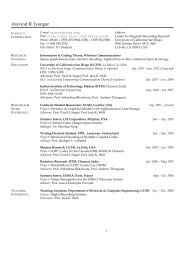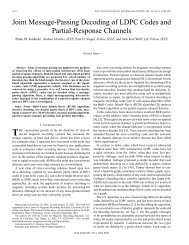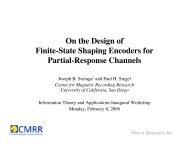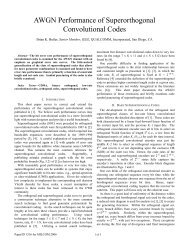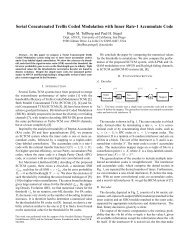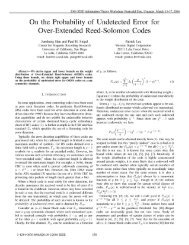Gaussian Belief Propagation for Solving Systems of Linear ... - arXiv
Gaussian Belief Propagation for Solving Systems of Linear ... - arXiv
Gaussian Belief Propagation for Solving Systems of Linear ... - arXiv
You also want an ePaper? Increase the reach of your titles
YUMPU automatically turns print PDFs into web optimized ePapers that Google loves.
30<br />
randomly-spread CDMA system (i.e. , a system where ρ(I n − R) ⋚ 1). 9 Thus <strong>Gaussian</strong>input<br />
additive white <strong>Gaussian</strong> noise CDMA is another example <strong>for</strong> which the proposed GaBP<br />
solver converges to the MAP decisions <strong>for</strong> any m ×n random spreading matrix S, regardless<br />
<strong>of</strong> the spectral radius.<br />
C. Numerical Example: Symmetric Non-PSD Indefinite) Data Matrix<br />
Consider the case <strong>of</strong> a linear system with a symmetric, but non-PSD data matrix<br />
⎛ ⎞<br />
1 2 3<br />
⎜ 2 2 1 ⎟<br />
⎝ ⎠ . (57)<br />
3 1 1<br />
Table VI displays the number <strong>of</strong> iterations required <strong>for</strong> convergence <strong>for</strong> the iterative methods<br />
under consideration. The classical methods diverge, even when aided with acceleration<br />
techniques. This behavior (at least without the acceleration) is not surprising in light <strong>of</strong><br />
Theorem 13. Again we observe that serial scheduling <strong>of</strong> the GaBP solver is superior parallel<br />
scheduling and that applying Steffensen iterations reduces the number <strong>of</strong> iterations in 45%<br />
in both cases. Note that SOR cannot be defined when the matrix is not PSD. By definition<br />
CG works only <strong>for</strong> symmetric PSD matrices. because the solution is a saddle point and not<br />
a minimum or maximum.<br />
IX. APPLICATION EXAMPLE: 2-D POISSON’S EQUATION<br />
One <strong>of</strong> the most common partial differential equations (PDEs) encountered in various areas<br />
<strong>of</strong> exact sciences and engineering (e.g. , heat flow, electrostatics, gravity, fluid flow, quantum<br />
mechanics, elasticity) is Poisson’s equation. In two dimensions, the equation is<br />
<strong>for</strong> {x, y} ∈ Ω, where<br />
∆u(x, y) = f(x, y), (58)<br />
∆(·) = ∂2 (·)<br />
∂x 2 + ∂2 (·)<br />
∂y 2 . (59)<br />
is the Laplacean operator and Ω is a bounded domain in R 2 . The solution is well defined<br />
only under boundary conditions, i.e. , the value <strong>of</strong> u(x, y) on the boundary <strong>of</strong> Ω is specified.<br />
We consider the simple (Dirichlet) case <strong>of</strong> u(x, y) = 0 <strong>for</strong> {x,y} on the boundary <strong>of</strong> Ω. This<br />
9 For non-<strong>Gaussian</strong> signaling, e.g. with binary input alphabet, this BP-based detector is conjectured to converge only in<br />
the large-system limit, as n, m → ∞ [36].


